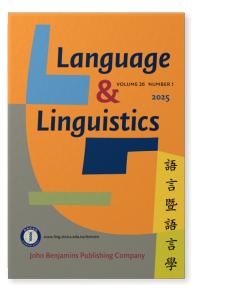Language and Linguistics | 語言暨語言學
Language and Linguistics is an academic publication of the Institute of Linguistics at Academia Sinica. Established in 2000, it publishes research in general and theoretical linguistics on the languages of East Asia and the Pacific region, including Sino-Tibetan, Austronesian, and the Austroasiatic and Altaic language families.
Since 2013, Language and Linguistics has been managed by an Editor-in-Chief, with internationally known scholars with different areas of expertise serving as Associate Editors, Editorial Board Members, and Reviewers, in order to present an informative, insightful scholarly dialogue.
To increase international citation rates and visibility, Language and Linguistics has been co-published with international publisher SAGE from 2014 to 2016 (Volume 15-17) and distributed worldwide. Beginning in 2017 (Volume 18), Language and Linguistics has been in partnership with John Benjamins Publishing Company, one of the leading publishers in the field of language and linguistics.
Language and Linguistics is an Open Access journal and the only international linguistic journal that publishes in both English and Traditional Chinese. The journal publishes a single volume yearly. Four issues are published per volume. Each volume contains three English issues (January, April, and October) and one Chinese issue (July). With original studies and a rigorous review process, the journal is indexed by the Social Science Citation Index (SSCI) and Arts & Humanities Citation Index (A&HCI), Bibliographie linguistique/Linguistic bibliography, CSA Linguistics & Language Behavior Abstracts (LLBA), Current Contents/Arts and Humanities, Journal Citation Reports/Social Sciences Edition, Linguistics Abstracts, MLA International Bibliography, SCOPUS, CNKI Scholar, Dimensions, Glottolog, and THCI.
Language and Linguistics seeks to provide research that is professional, insightful, and current, and welcomes submissions in all areas of linguistics.
Language and Linguistics publishes its articles Online First.
To submit papers or monographs, please visit https://llsubmit.ling.sinica.edu.tw
For more information of L&L, please visit https://www.ling.sinica.edu.tw/item/en
Volumes 1-17 can be freely downloaded from: https://www.ling.sinica.edu.tw/item/en?act=journal
Volumes 18 and onward are freely accessible on both L&L’s websiteand on the John Benjamins e-Platform. Most of these volumes were first made Open Access under a CC BY-NC 4.0 license. It has now (January 2023) been decided to change this to the more liberal CC BY 4.0 license. Please note that while we are in the process of making this change, information about licenses can vary between the Benjamins website, platform and in the articles themselves.
Latest articles
7 October 2024
20 September 2024
19 September 2024
13 September 2024
12 September 2024
6 September 2024
29 August 2024
27 August 2024
15 August 2024
9 August 2024
22 July 2024
19 July 2024
8 July 2024
2 July 2024
27 June 2024
21 June 2024
30 May 2024
22 April 2024
2 April 2024
2 January 2024
14 September 2023
10 July 2023
9 April 2023
12 December 2022
12 October 2022
13 July 2022
29 April 2022
15 December 2021
29 October 2021
11 May 2021
17 April 2021
16 December 2020
18 October 2020
16 July 2020
2 April 2020
2 January 2020
24 October 2019
14 July 2019
5 April 2019
2 January 2019
10 October 2018
4 July 2018
15 April 2018
5 January 2018
10 October 2017
31 July 2017
10 April 2017
12 January 2017
Issues
Online-first articlesVolume 26 (2025)
Volume 25 (2024)
Volume 24 (2023)
Volume 23 (2022)
Volume 22 (2021)
Volume 21 (2020)
Volume 20 (2019)
Volume 19 (2018)
Volume 18 (2017)
Board
Subscription Info
General information about our electronic journals.
Subscription rates
All prices for print + online include postage/handling.
| Online-only | Print + online | ||
|---|---|---|---|
| Volume 26 (2025): 4 issues; ca. 800 pp. | Open Access | EUR |
Available back-volumes
| Online-only | Print + online | ||
|---|---|---|---|
| Complete backset (Vols. 18‒25; 2017‒2024) |
32 issues; 5,900 pp. |
Open Access | EUR 2,592.00 |
| Volume 25 (2024) | 4 issues; 800 pp. | Open Access | EUR |
| Volume 24 (2023) | 4 issues; 800 pp. | Open Access | EUR |
| Volumes 21‒23 (2020‒2022) | 4 issues; avg. 733 pp. | Open Access | EUR |
| Volume 20 (2019) | 4 issues; 700 pp. | Open Access | EUR |
| Volume 19 (2018) | 4 issues; 700 pp. | Open Access | EUR |
| Volume 18 (2017) | 4 issues; 700 pp. | Open Access | EUR |
Submission
Language and Linguistics invites contributions relevant to the aim and scope of the journal, which can be submitted through the journal's online submission portal .
Before submitting, please consult these guidelines.
If you are not able to submit online, or for any other editorial correspondence – inquiries regarding suitable topics, length of manuscripts, reviews, etc. – please contact the editors via e-mail: LLeditor
Ethics
John Benjamins journals are committed to maintaining the highest standards of publication ethics and to supporting ethical research practices.
Authors and reviewers are kindly requested to read this Ethics Statement .
Please also note the guidance on the use of (generative) AI in the statement.
Rights and Permissions
Authors must ensure that they have permission to use any third-party material in their contribution; the permission should include perpetual (not time-limited) world-wide distribution in print and electronic format.
For information on authors' rights, please consult the rights information page.
Open Access
As of 2022, Language and Linguistics is published Open Access through sponsorship of Academia Sinica, with no author fees. By default, articles are made available Open Access under a Creative Commons Attribution-NonCommercial 4.0 International (CC BY-NC 4.0) license, but other licenses can be discussed at the author's request.
Archiving
John Benjamins Publishing Company has an agreement in place with Portico for the archiving of all its online journals and e-books.
